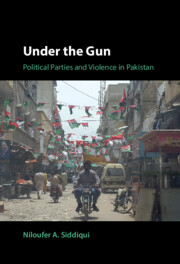Book contents
- Under the Gun
- Under the Gun
- Copyright page
- Dedication
- Contents
- Figures
- Tables
- Acknowledgments
- Abbreviations
- 1 Introduction
- 2 The Logic of Party Violence
- 3 Setting the Stage
- 4 Who Owns the Guns? the Muttahida Qaumi Movement and Violence in Karachi
- 5 The Pakistan Peoples Party and the Gangs of Lyari, Karachi
- 6 Allying with Militants? the Pakistan Muslim League-Nawaz and Sectarian Groups in Punjab
- 7 An Ideology of Nonviolence? the Awami National Party in Khyber Pakhtunkhwa
- 8 Party Violence in Comparative Perspective
- 9 Conclusion
- Appendix
- Bibliography
- Index
5 - The Pakistan Peoples Party and the Gangs of Lyari, Karachi
Published online by Cambridge University Press: 18 November 2022
- Under the Gun
- Under the Gun
- Copyright page
- Dedication
- Contents
- Figures
- Tables
- Acknowledgments
- Abbreviations
- 1 Introduction
- 2 The Logic of Party Violence
- 3 Setting the Stage
- 4 Who Owns the Guns? the Muttahida Qaumi Movement and Violence in Karachi
- 5 The Pakistan Peoples Party and the Gangs of Lyari, Karachi
- 6 Allying with Militants? the Pakistan Muslim League-Nawaz and Sectarian Groups in Punjab
- 7 An Ideology of Nonviolence? the Awami National Party in Khyber Pakhtunkhwa
- 8 Party Violence in Comparative Perspective
- 9 Conclusion
- Appendix
- Bibliography
- Index
Summary
Chapter 5 turns to the strategy of violence outsourcing by examining a party that shared many of the same incentives in Karachi as the Muttahida Qaumi Movement for carrying out violence but which did not possess the capacity to do so itself. I focus on how the Pakistan People’s Party (PPP) relied on the People’s Aman Committee (PAC), an ethnic militia in Karachi, both to meet the demands of its constituents in the neighborhood of Lyari and to carry out the “dirty work” of violence, intimidation, and extortion. Through the PAC, the PPP was able to engage in voter fraud and intimidation; engage in criminal activity and ‘turf wars’ with the MQM and ANP over valuable economic property; and maintain support among its co-ethnic base by further polarizing the electorate along ethnic lines. In Karachi’s polarized environment, the PPP had a generally captive support base of Sindhi and Baloch voters in the city who imposed minimal electoral costs on the party for violence given their lack of alternative options. Despite evident principal–agent problems, the PPP relied on the gang because it did not have the local-level organizational capacity to carry out violence – or gather votes – itself.
Keywords
- Type
- Chapter
- Information
- Under the GunPolitical Parties and Violence in Pakistan, pp. 113 - 139Publisher: Cambridge University PressPrint publication year: 2022

